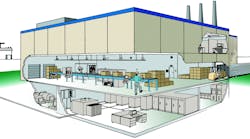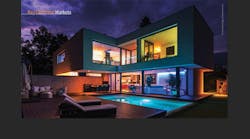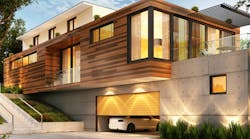Distributors, reps, manufacturers and end users have a ringside seat for one of the lighting industry's most exciting developments in years: the emergence of the light-emitting-diode (LED) as a viable source of illumination for general-purpose lighting.
Most electrical professionals are vaguely familiar with LEDs from their applications in traffic signals, exit signs, automobile lighting and consumer electronics. They may even know LEDs are starting to work their way into white-light applications, but can't yet compete cost-effectively with traditional lamps. But they may not have thought through the impact LEDs will have on the lighting fixtures that will house them and direct the light they produce.
For conventional lamps, lighting fixtures were simply an assembly of one or more distinct light sources (glass lamps) inserted into a socket and mounted on a metal pan, or housing. As a close relative of the computer chip, an individual LED consists of a tiny die with a heat sink for thermal management; a printed circuit board for mounting the die; a power supply (also called a driver); primary and secondary optics; and other physical/ mechanical features such as a mounting frame and a flat lens, or diffuser.
Since an LED sends out light in a specific direction with a somewhat confined beam, almost all the generated lumens can be focused toward a lens. This is why LEDs can redefine the whole idea of a lighting fixture. A number of individual LED dies can be put into an array and mounted within a panel, or a bar, so the “fixture” can be any size or shape. LEDs are even being mounted on sticky-back tape so that lighting designers can mount them wherever needed. As shown in several of the photos accompanying this article, many of the current LED fixtures are basically replicas of existing lamp designs. LED lamps are already available that resemble incandescent and fluorescent lamps, so they can be slotted into the sockets and housings of existing fixtures. That product approach can result in both good and bad light distributions, and it postpones the real question of what a LED fixture should look like and how it should be maintained. Manufacturers will also have to answer the question: With LEDs, will we change out the entire fixture, or just the LED board?
Nearly every manufacturer advertises LED fixtures as being sustainable, but we don't know if their current products will continue to be available for any longer than a year or two. If replacement requires changing the entire fixture, will the new model have the same luminous qualities as the old adjacent fixtures in the room: brightness, color characteristics, controllability and light distribution? If the fixture has connectors for “swapping out” the LED array and driver without changing the housing, we might have a long-lived, sustainable fixture.
An approach some manufacturers are taking is to offer an LED module that replaces the “guts” of certain existing installed downlight fixtures. A downlight takes advantage of the inherently directional nature of light emitted from LEDs by minimizing light loss within the fixture, which can be quite high for conventional sources.
Although lighting designers love to use LEDs in dazzling color-changing schemes, such as on the sides of buildings, on walls in nightclubs, in signage and other high-visibility applications, this will be a relatively limited market. The big market is general lighting applications for indoor spaces. This is where blue LEDs manufactured with a phosphor coating over the lens to produce a white can take center stage, and why chip makers are working hard to reduce color inconsistencies with their white LEDs. LEDs are not quite ready for widespread use in general lighting applications, but the day is coming soon when all electrical distributors will stock them. Before starting to sell LEDs, distributors should be aware of their key technical advantages:
Useful life
LEDs can have anywhere from three to 25 times longer life than today's lamps. Traditionally, a lamp manufacturer shows rated life in a catalog as the point at which half of the lamps in an installation have burned out. But LEDs don't burn out — they have a passive end of life, with the light output diminishing over time, similar to what happens with a mercury-vapor lamp. So the definition of an LED's “lifetime” should be the number of hours for the source output to decline to a certain percentage, perhaps 70 percent of its initial output.
Lumen output
Standard lamps generally have lumen ratings for initial and mean lumens and these published figures are consistent within a manufacturing run of the product. However, LED lumen output can vary as much as 20 percent from one die to another in a typical manufacturing run of the product. Additionally, the lumen output of a group of LEDs when assembled into a fixture can suffer if the fixture design restricts heat dissipation and the LED operates at a junction temperature higher than optimum.
Color
After dies are made, companies “bin” their LEDs, a procedure that involves inspecting and sorting the individual dies into batches of products that have a similar color appearance and light output. The tighter the color range specified by a lighting fixture manufacturer, the higher the die manufacturing costs, but the better the color results.
Fixture performance/characteristics
Typically, a lighting fixture is tested for its performance and photometry in an ambient temperature of 25°C / 77°F. Generally, an LED produces more light the cooler it is, since the lumen output and useful life is directly dependent on the temperature at the junction, the region behind the die. This is why manufacturers state the maximum allowable junction temperature at the die. Increasing current flow to the LED will also raise operating temperature, and LEDs from the same manufacturing run can vary greatly in input watt consumption from the published value.
Looking ahead
Exterior street and parking lot/garage lighting seems to be the first wide application of LEDs in the general-lighting market because these low-profile luminaires use cool-white LED sources (from 4,000K to 6,000K, with higher efficiency than warm white sources). Also, in these applications an extended operating life of five to seven years means maintenance and energy costs are much lower than with HID lamps. Additional LED features include maintained light levels over wide temperature gradients and a highly directional beam pattern that can provide excellent uniformity, precise cutoff characteristics and enhanced vertical light levels. LEDs are not miracle light sources, as manufacturers have a ways to go before they can compete cost-competitively with conventional lighting systems in general-purpose lighting applications.
The author has been covering lighting for Electrical Wholesaling and Electrical Construction & Maintenance magazines for more than 40 years and is respected as one of the most knowledgeable technical lighting writers in North America.
How LEDs operate
An LED is a semiconductor diode that emits light when an electric current is applied in one direction only (in the forward direction of the device). The saturated color (that is, a single monochromatic color) of the light depends on the composition of the material, so it can be infrared, visible or ultraviolet.
The first practical LED operating in the red portion of the visible spectrum hit the market in 1962. And over the past 30 years, low brightness LEDs have pushed into a few markets where the saturated colors are ideal for indicator lights, traffic signals and exit signs. Then in the 1990s the development of both high-brightness and blue LEDs helped expand application possibilities for LEDs. High brightness means an individual chip can deliver more lumens than was previously possible. The blue color is significant because it can be mixed with a red and a green LED to create white light. The blue LED is also combined with a phosphor coating to achieve white light.
The advantages of LEDs include long life and high efficiency; no breakable filament or arc tube; small size; low radiated heat; high reliability (resistant to shock and vibration); and the absence of infrared and ultraviolet energy. In addition to operating on low-voltage DC power, which facilitates dimming and rapid on-off control, an LED can also be served by AC power, and can start instantly at temperatures as low as -40°C.
Like a normal diode, the LED places together two semi-conducting materials (such as gallium indium nitride) impregnated, or doped, with impurities to create a p-n junction. When electricity flows through the diode, which is also called a die or a chip, the atoms in one material (inside the semiconductor chip) are excited to a higher energy level. The atoms in that first material have too much energy (too many electrons) and need to release that energy. The energy is released as the atoms shed electrons to the other material within the chip. During this energy release light is created in the form of a photon.
Because of the limitations of phosphor technology, some years ago, the fluorescent industry introduced subjective terms such as “cool white” and “warm white” for their linear lamps to draw comparisons to the color of incandescent light. LEDs makers have adopted the same concept, creating two broad families of products: warm (in the 3,200K range) and cool (in the 5,500K range). The warm-white LED is designed to “match” the “warm-white” color temperature of the halogen and incandescent lamps so popular with users over the years.
Another important concern is the color rendering and the color consistency of LEDs. The widely used standard for color evaluation is the Color Rendering Index (CRI) established by the International Commission on Illumination (CIE), defined in “13.3-1995 Method of Measuring and Specifying Colour Rendering Properties of Light Sources.” Developed in 1964, this index is based on color models with broad spectral distributions. However, white LEDs are narrow band sources, so as mentioned above, color temperature may be a more suitable reference tool for now. The recent release of ANSI C78.377, “Specifications for Chromaticity of Solid-State Lighting Products,” references the CRI standard, but a revised, or updated, color rating system is proposed for the unique characteristics of the LED.
The U.S. Department of Energy (DOE) is investing in solid-state lighting (SSL) and in Sept. 2007 released standards for LED lighting through its Energy Star program. In addition, the SSL Commercial Product Testing Program reviews LED luminaire performance using four characteristics: luminaire light output, (lumens); luminaire efficacy (lumens per watt); correlated color temperature (degrees Kelvin) and the color-rendering index.
DOE is also working with ANSI, the Illuminating Engineering Society of North America (IESNA), NEMA and UL in creating useful standards and performance criteria. It wants to avoid the problems seen a few years ago in the compact fluorescent lamp (CFL), when some manufacturers rushed CFLs to market with a lack of precise performance data and inadequate education of users. A 2006 DOE report, “Compact Fluorescent Lighting in America: Lessons Learned on the Way to Market,” describes what happened with CFLs.








